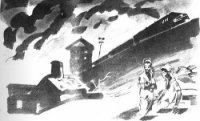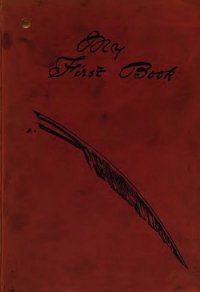Operation Nemesis: The Assassination Plot that Avenged the Armenian Genocide - Bogosian Eric (мир книг .txt) 📗
5) The Muslim population was warned that Armenians who ran away or tried to hide would be executed. Any Muslim who attempted to conceal or in any way aid an Armenian would be punished by death, and his or her family would likewise be executed and their house razed. All Armenians were included in the caravans. No exceptions were allowed for age or disability. The only Armenians permitted to stay behind were those who either had a secure job within a consulate or a hospital or whose skills might benefit the war effort (e.g., working in a flour mill).8 Eventually every Armenian, whatever his or her value to Turkey, was to be deported. Farmers were killed or exiled before they could harvest their crops, resulting in grain shortages and famine.
6) Guarded by soldiers, police, or chetes, the caravans were led into the frontier. Harassment and killings began soon after they left the populated areas. The persecution ranged from small boys throwing stones to theft, beatings, the abduction and rape of young women, and murder. Kurds were allowed to attack the caravan in order to kidnap young women and children or rob those who might have valuables with them; minor infractions were met with whippings, bayoneting, or shooting. Suicides were common. Often the pious would rather die than renounce their Christian faith, as their captors demanded. Others suffered permanent psychological harm.
7) As the caravans continued along the meandering semi-desert tracks, hunger, thirst, and relentless heat would take their toll. Deportees were often forbidden to drink from springs. The weak, primarily the elderly and very young, were left by the roadside to die. (After numerous reports of corpses cluttering the roads, Talat Pasha sent out strict directives to bury all the dead.) The caravans were quickly transformed into a ragtag collection of starving people dragging their emaciated bodies through the desert. There was little chance that the old, infirm, or very young would survive more than a week of this torture. Young women were kidnapped into households, boys taken as slaves (often as shepherds). The only men who survived were those who escaped and ran.
8) The ultimate destination was a string of outposts in the Syrian desert, particularly the oasis town of Der Zor. Here, with little shelter and no facilities for basic hygiene, the remaining deportees died from hunger and disease. The camps were regularly culled through outright executions in order to make room for new arrivals. Thousands of children were left orphaned.
There were innumerable witnesses. Commissioner Giacomo Gorrini, who was stationed as the Italian consul general in Trebizond in northeastern Anatolia on the Black Sea, wrote:
There were about 14,000 Armenians at Trebizond—Gregorians, Catholics, and Protestants. They had never caused disorders or given occasion for collective measures of police. When I left Trebizond, not a hundred of them remained. From the 24th June, the date of the publication of the infamous decree, until the 23rd July, the date of my own departure from Trebizond, I no longer slept or ate; I was given over to nerves and nausea, so terrible was the torment of having to look on at the wholesale execution of these defenceless, innocent creatures.
The passing of the gangs of Armenian exiles beneath the windows and before the door of the Consulate; their prayers for help, when neither I nor any other could do anything to answer them; the city in a state of siege, guarded at every point by 15,000 troops in complete war equipment, by thousands of police agents, by bands of volunteers and by the members of the “Committee of Union and Progress”; the lamentations, the tears, the abandonments, the imprecations, the many suicides, the instantaneous deaths from sheer terror, the sudden unhingeing of men’s reason, the conflagrations, the shooting of victims in the city, the ruthless searches through the houses and in the countryside; the hundreds of corpses found every day along the exile road; the young women converted by force to Islam or exiled like the rest; the children torn away from their families or from the Christian schools, and handed over by force to Moslem families, or else placed by hundreds on board ship in nothing but their shirts, and then capsized and drowned in the Black Sea and the River Deyirmen Dere—these are my last ineffaceable memories of Trebizond, memories which still, at a month’s distance, torment my soul and almost drive me frantic.9
One group remained dedicated to aiding the Armenians: the Christian missionaries. They pleaded with American diplomats to intercede.10 Ambassador Morgenthau, in turn, made it his duty to lobby on behalf of the Armenians and wrote long essays on the plight of the Armenians, which eventually became books. Ambassador Morgenthau’s Story has long been a cornerstone of the case against the Young Turks. Morgenthau knew Talat personally and had many tributaries of reportage finding their way to him. “I now see what was not apparent in those early months,” he wrote, “that the Turkish Government was determined to keep the news, as long as possible, from the outside world. It was clearly the intention that Europe and America should hear of the annihilation of the Armenian race only after that annihilation had been accomplished.” Though Morgenthau was stationed in Constantinople and did not personally witness the evacuation and slaughter of the Armenian villagers, he was entirely convinced by those on the front lines who reported what they had seen. “For hours, [the missionaries] would sit in my office and, with tears streaming down their faces, they would tell me of the horrors through which they had passed. Many of these, both men and women, were almost broken in health from the scenes they had witnessed.”11
Missionaries had begun to flood into the region in the last half of the nineteenth century as the dire straits of the Christian population became better publicized. Though the missionaries hailed from several European countries, many were Americans affiliated with the American Board of Commissioners for Foreign Missions. The ABCFM was founded in 1810, part of the wave known as the “Second Great Awakening,” which fostered missions, antislavery movements, temperance campaigns, and pacifism around the world. This organization, affiliated with several Protestant churches, had been conceived of by a group of students from Williams College who brought the idea of foreign proselytizing to the Andover Theological Seminary. During the nineteenth century, the ABCFM flourished and had a profound effect on the course of world events. Missions were founded not only in the Ottoman Empire but also in Africa, Siam (Thailand), Ceylon (Sri Lanka), India, and the Sandwich Islands (Hawaii),12 where the missionaries set in motion forces that would lead the United States to annex the islands in 1898. The ABCFM spread not only the words of Christ but also, infused with a belief in manifest destiny and social Darwinism, a deep commitment to the idea that the American way was superlative. The “object of the missions was moral renovation of the world,” wrote Joseph L. Grabill, bringing with them a new way of living embodied in “glass windows, wooden floors, wagons, clocks, sewing machines, organs, cotton gins [and] telegraph instruments.”13
Beginning in the early nineteenth century, the first waves of American Protestant missionaries met resistance as they arrived to make converts in the Levant. The Jews, having had their fill of Christians in Europe, wanted to be left alone. The Greek patriarch had no use for competition and openly warred with the missions. Some Muslims were curious, but Sharia law dictated that the punishment for apostasy was death. And any Catholics in the region naturally wanted nothing to do with Protestant missionaries.




